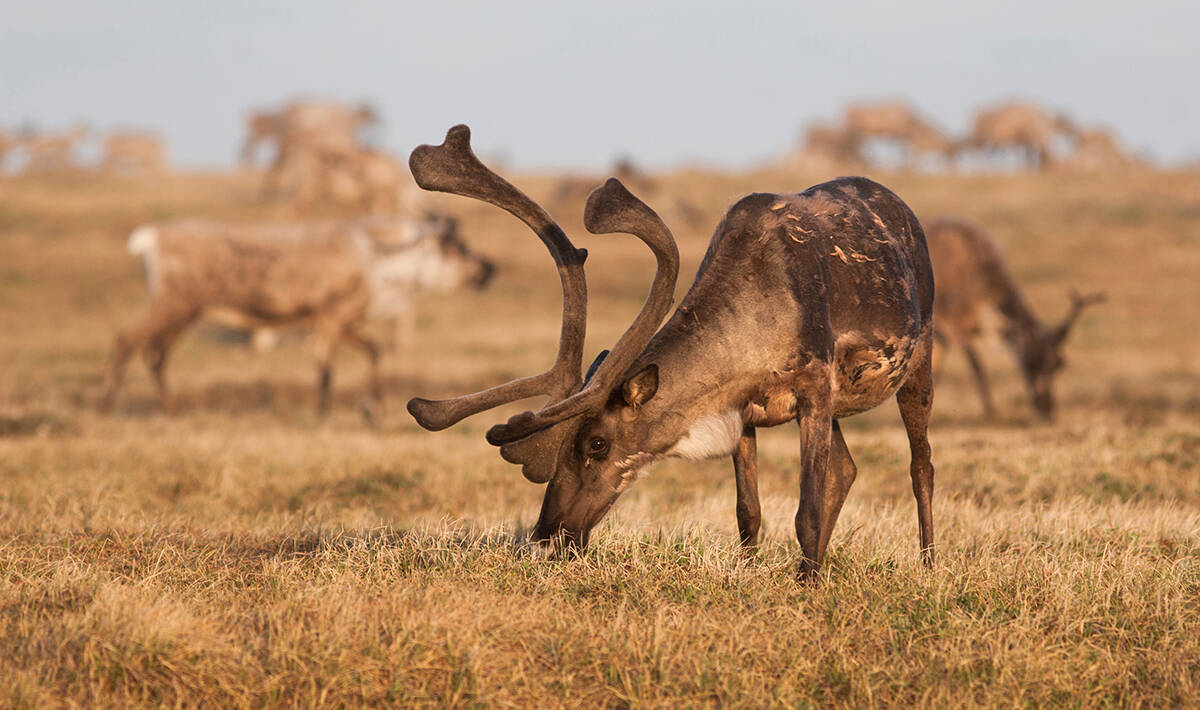Driving home the other day, my friend and I came across a big bull caribou chasing several cows down Kalifornsky Beach Road. One hundred yards behind them lagged a young bull trailing the group.
As the young bull attempted to approach the group of cows, the older bull wheeled around and slammed into the younger bull, driving him to the ground with his massive antlers. Having no chance in the fight, the smaller bull sprinted away as soon as he regained his footing.
That sighting quickly turned into a discussion of the caribou breeding system, commonly referred to as the rut, and how it differs from the more familiar moose rut on the Kenai Peninsula.
For caribou, pre-rut behaviors begin during late August and early September, when many caribou herds start their seasonal migrations between summer and winter ranges. While on these migrations, bulls begin to strip the velvet from their antlers and rake vegetation in order to strengthen their neck muscles and harden their antlers that will be used in fights for dominance during the coming months.
During this time, bulls also begin to produce increased amounts of testosterone and other steroid hormones, increasing muscle strength and giving rutting bulls their thick-necked appearance during the rut. As these hormones continue to take effect, bulls become increasingly irritable and aggressive, particularly toward other bulls.
By late September, sparring with other males begins to get more serious. By October, cow caribou come into estrus, and the rut goes into full swing. Most fights between bulls are brief and do not result in serious injuries. However, skirmishes between equally matched dominant bulls vying for access to cows can turn violent.
Compared to many other deer species, the caribou rut is a loosely organized affair. Caribou move into general rutting areas and form large aggregations with bulls and cows mixed together. Bull caribou are not territorial, but they do attempt to control a personal space around themselves and breed any receptive cows within this area.
Larger bulls follow groups of cows and try to prevent other bulls from breeding with the females within their perceived area. Cows generally want to breed with the more dominant bulls in the area, and so groups of receptive cows will often congregate around larger or more dominant bulls.
In contrast to caribou’s relatively disorganized breeding system, moose in Alaska use a more structured breeding system. Similar to caribou, bull moose begin to strip the velvet from their antlers in late August and early September. Again, bulls begin to produce more testosterone and other steroid hormones in preparation for the rut.
During September, bull moose begin moving into rutting areas, searching for cows, and they start marking these areas. Bulls rake vegetation to strengthen their neck muscles, but dominant bulls also begin to scent mark their rutting areas with urine.
Dominant bulls use their forefeet and antlers to scrape out large pits in the ground called wallows. Bulls also urinate in wallows and often roll around in the mud and urine to spread their scent and advertise their presence in the area.
As the bulls prepare their rutting areas and the rut gets into full swing, cow moose congregate in these open areas and form rutting groups around dominant bulls. Caribou typically don’t vocalize much, even during the rut. However, both cow and bull moose make interesting vocalizations to announce their presence and attract one another.
Dominant bull moose defend their rutting area and their group of cows, known as a harem, from other bulls. The dominant bull keeps his cows close and breeds the cows in his group as they come into estrus. Younger bulls, commonly called satellite bulls, will linger on the periphery of rutting areas trying to gain access to the females when the dominant bull is distracted.
However, the dominant bull will generally keep other bulls away from the cows and will do most of the breeding. When two dominant bulls meet in a rutting area, the battle for dominance and access to the harem can be epic.
For both caribou and moose, the energetic costs of the rut are great. During the productive summer months, bulls of both species build up remarkable fat stores. However, the energetic demands of the rut and injuries sustained during bouts for dominance can take their toll.
Bulls are sometimes seriously injured during these fights and may even die from their wounds. Some bulls will also expend too much energy during the rut and exhaust their fat stores before the end of winter. Injured or exhausted bulls often become easy prey for wolves and bears.
But, for those that make it through, the cycle begins again in spring when bulls of both species begin to grow their antlers for the next rut.
Dom Watts is a pilot and wildlife biologist at Kenai National Wildlife Refuge. Find more Refuge Notebook articles (1999–present) at https://www.fws.gov/refuge/Kenai/community/refuge_notebook.html.


